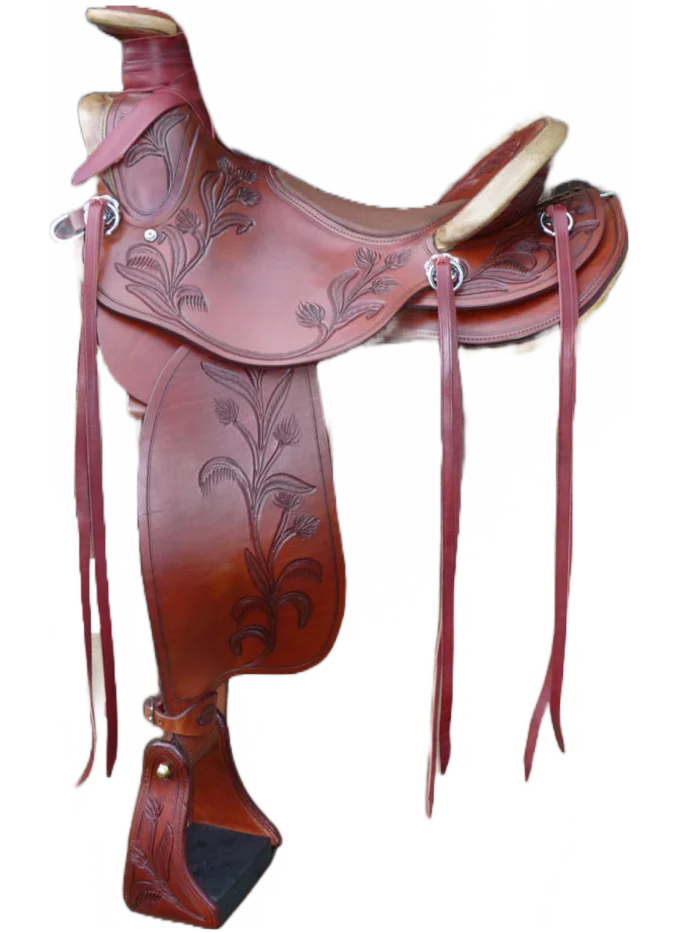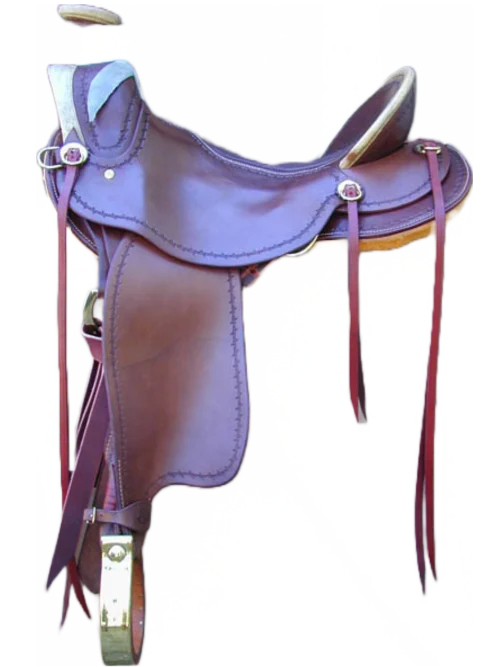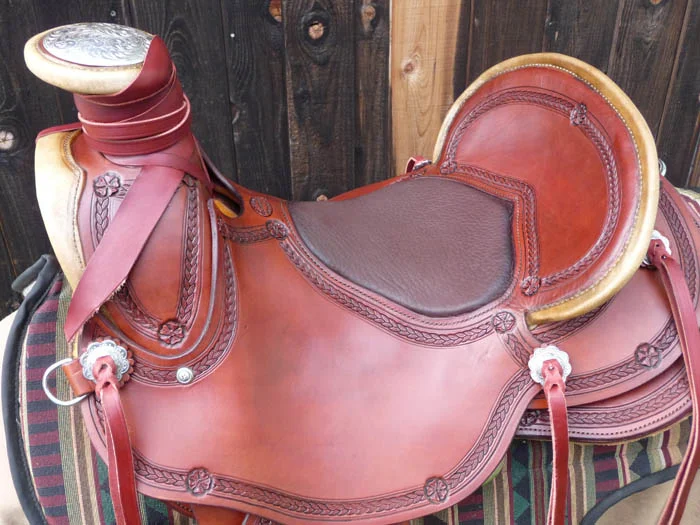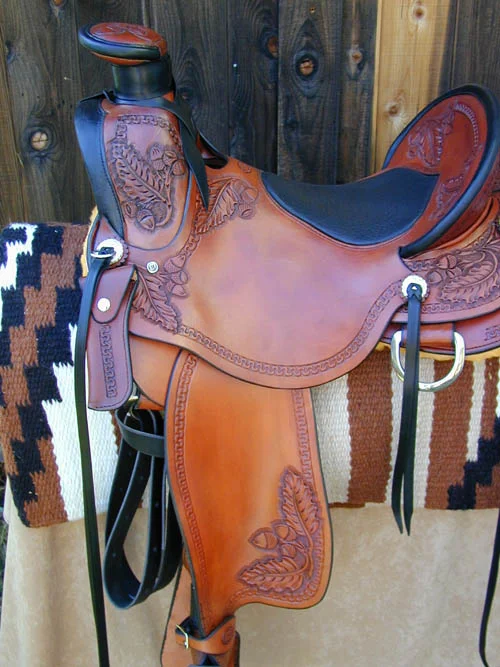"We can fit your horse or mule"
Menu

 Stamp Patterns
Stamp Patterns Border Patters
Border Patters Other Patterns
Other PatternsWe offer seven biblically symbolic tooling patterns. Each comes with a numbered, signed certificate, that explains the art and scriptures that each is based on. Here are photos and descriptions of each pattern. You can read more about the vision behind the patterns on the About Our Tooling Patterns page.
The Red Sea Drifter is based on the parable of the wheat and the tares found in Matthew 13:24-30.
When the Israelites crossed the Red Sea, they had wandered in the desert for 40 years. They had good and bad times. They grumbled against God, and they praised Him too. They met good people and troublesome people. Through all these things, God guided them until they reached the promised land.
We have similar circumstances in our own lives. We experience good and bad times, but God still guides us through life until we meet Him in the promised land.
The tooling on this saddle is the wheat and the tare. The wheat plant is the nourishing plant that gives life in many different ways. In contrast, we have the tare plant which is more than just a weed. The tare, according to the Bible dictionary, is a plant that if mistakenly eaten, will cause convulsions and even death. When the wheat and tares are found growing together, it is very difficult to tell them apart until they are fully mature. Even then it is next to impossible to remove the tares without removing some of the life-giving wheat also.
Sin in our lives as well as temptations and tempters we meet, produce the same effects as the tares. Our Father in heaven can’t remove them without removing some of the wheat also, but rejoice for the harvest is near.
The plant chosen for this tooling pattern is called the caper. It is a member of the hyssop family, which is used in the Jewish rituals of worship, for purification. The caper is used to prepare certain dishes, to enhance the taste of the food by purifying the palette.
In Exodus, chapter 12, the Bible tells of the Israelites leaving Egypt. They were leaving a life of slavery and bondage, looking to receiving the freedom and promises of God. We are told in Isaiah 58:6-14 how to find the freedom and promises of God, and that is by doing what God wants us to do.
In Mark 12:29, Jesus tells that the greatest commandment is to love the Lord thy God with all your heart, mind, soul, and strength. 2nd Corinthians 6:14-18, tells us to fellowship with Godly people and to be separated from the world. 2nd Corinthians 7:1 says, “Since we have these promises, dear friends, let us purify ourselves from everything that contaminates the body and spirit, perfecting holiness out of reverence for God.
Thus we make our Exodus.
The artwork on this saddle is symbolic of the new covenant that God has made with mankind. On the rear jockies and fork, you will find the rose, mustard, and myrtle plants which represent people. They have been collected in a basket, yet are receiving no nutrients to sustain them. The lily is the strong nurturing plant watching over all the wild flowers that have been grafted in. The lily represents Jesus, God’s sacrifice in the new covenant.(Song of Songs 2:1) In Jeremiah 31:27- 33 we read of God’s promise to raise up His people, to nurture and watch over them, as well as make a new covenant with them so they could be with Him forever. The old covenant consisted of people following the Law of Moses, but in Hebrews 8:7-13, we find that God puts His laws in everyone’s mind and heart. We know right from wrong. In Romans 11:22-24 we find that we can become part of God’s family by being grafted into the lily(fenders), as well as others that are waiting (rear jockies and fork). What the Bible teaches us is that through putting our trust and faith in Jesus (Romans 3:21-31), we too go from waiting to being grafted, to being grafted into Him. It all comes down to a choice. Romans 10:9-13.
The Prophet tooling pattern is based on Matthew 12:38-41 and Matthew 16:4. The flowers are gourd and spikenard. Both are leaves and blossoms.
In the book of Jonah, Jonah went to Nineveh, and waited under a gourd plant for God to destroy the city. Before Jonah came to Nineveh, he spent 3 days in the belly of a fish. Thus, we have the symbolism of the gourd plant.
The spikenard represents the only anointing Jesus ever received for His death, John 12: 1-8. Mary anointed Jesus with nard, which at that time was a very expensive perfume. This perfume came from the spikenard plant.
In summary, this tooling pattern shows the sign we are given through Jesus death, just as Jonah was in the belly of a fish for 3 days, to bring Nineveh to repentance, so was Jesus in the depths of the earth for 3 days to bring us to repentance and give us access to the Father.
The chariot is a vehicle. A vehicle is a means of accomplishing or causing something to happen.
In the New Testament, the Greek word for chariot is “harma”. The definition of “harma” is to make union, or to raise, or to fit together. God’s purpose for us is to help others be raised up to be fitted into God’s kingdom.
In Matthew chapter 24, Jesus was talking to His disciples and telling them of the signs of the end of the age. As we read, we find that verses 36-47 tell us that we are God’s chariot, or vehicle. We are the ones God uses to accomplish His work. Which brings us to the symbolism of the this tooling pattern.
The flower on this saddle, is the apple blossom. The apple blossom shown here is doing what it was designed to do.
Each and everyone of us has a Godly purpose for living this life and that is to do what God is telling us. Remember the words of Jesus in Matthew 24:46, “It will be good for that servant whose master finds him doing so when He returns.”
This tooling pattern is designed to show God’s provision for mankind by showing us the sacrifice the Lord Jesus made for us.
The domestic rose has been chosen to represent Jesus. On the fenders you will find the rose coiled around the stamped column. This is based on Numbers 21:8- 9 Jesus said, “As Moses lifted up the serpent in the wilderness, so shall the son of man be lifted up.” This is the healing received from Jesus who was crucified for us. On the rear jockeys, you will find the olive branch on each side of the rose. This is based on Zach. 4: 1-6. “Not by might, nor by power, but by my spirit says the Lord.” The rose represents the lamp stand. The lamp stand is Jesus in the book of Revelations. In the front of the seat, there is a rose that appears to part the seat. This represents the curtain in the temple that separated mankind from the Holy of Holies. Matthew 27:51 and Mark 15: 38
In summary, the message on this saddle shows the healing we have by gazing on the cross, joined with the access we have to the Father because of the removal of the veil to the Holy of Holies, by the great high priest, Jesus. All this is done not by anything we do, but by the Spirit of God that draws us to the cross.
The Promised Land pattern is based in Isaiah chapter 58. This chapter is on true fasting. I believe this chapter encompasses all the principles found in the story of Israel entering the promised land. In Numbers 13:26-33, we see that a short time after leaving Egypt, they arrived at the banks of the Jordan River. Spies were sent out, and a report was brought back. God had promised this land across the Jordan to the Israelites, but they chose to go see if it was true. The report came back, and all but Caleb were afraid to enter the land. Even though they saw the good things God offered them, they were afraid of the giants in the land. They chose not to believe God, and therefore, they didn’t receive His promise. However, Caleb, who chose to believe God, did receive the promised land God had offered.
I believe that in Isaiah, we read that the people are asking God why he doesn’t answer their prayers, or why He doesn’t fulfill His promises. They are told that He doesn’t because they don’t listen to what He is telling them to do.
We read that true fasting is doing what is God’s will, and His will is that we share food with the hungry, shelter the poor, and clothe the naked. In other words, give to others around us, as best we can.
This brings us to the tooling pattern on this saddle. The key here is the clover. The clover plant builds more nitrogen in the soil than what it uses. In other words, it gives more to the other plants and environment around it than it takes from it.
God promises us in Isaiah, that if we do these things, then our light will break forth like the dawn, and we will walk with God. The clover is instrumental in nourishing an environment far beyond its own life.
I believe by following these principles we will receive the Promised Land of Isaiah, chapter 58.
Stamp Patterns
Our tooling patterns that show a mix of floral and a stamp are normally done with a basket weave. However, the basket weave can be substituted for one of our other stamp patterns. If you prefer no floral, and just a corner stamp or even a fully stamped saddle are available upon request. Check out the photos to see examples.
![]()
Stamp Pattern 1
Corner basket weave on a Trail Reiner.
![]()
Stamp Pattern 2
Basket Weave Stamp
![]()
Stamp Pattern 3
Diamond Stamp
![]()
Stam Pattern 4
Waffle Stamp
![]()
Stamp Pattern 5
Tri Stamp
![]()
Stamp Pattern 6
![]()
Stamp Pattern 7
![]()
Stamp Pattern 8
PinwheelStamp-Natural Leather/nopaste
![]()
Stamp Pattern 9
Border Patterns
Here are our border patterns
![]()
Border Pattern 1
Rope border w/flower stamp/Wade trail saddle
![]()
Border Pattern 2
![]()
Border Pattern 3
Barbwire border/Wade trail saddle
![]()
Border Pattern 4
![]()
Border Pattern 5
Small serpentine w/oak & acorn tooling/Wade trail saddle
![]()
Border Pattern 6
Bead border/no bead
![]()
Border Pattern 7
![]()
Border Pattern 8

We offer seven biblically symbolic tooling patterns. Each comes with a numbered, signed certificate, that explains the art and scriptures that each is based on. Here are photos and descriptions of each pattern. You can read more about the vision behind the patterns on the About Our Tooling Patterns page.
The Red Sea Drifter is based on the parable of the wheat and the tares found in Matthew 13:24-30.
When the Israelites crossed the Red Sea, they had wandered in the desert for 40 years. They had good and bad times. They grumbled against God, and they praised Him too. They met good people and troublesome people. Through all these things, God guided them until they reached the promised land.
We have similar circumstances in our own lives. We experience good and bad times, but God still guides us through life until we meet Him in the promised land.
The tooling on this saddle is the wheat and the tare. The wheat plant is the nourishing plant that gives life in many different ways. In contrast, we have the tare plant which is more than just a weed. The tare, according to the Bible dictionary, is a plant that if mistakenly eaten, will cause convulsions and even death. When the wheat and tares are found growing together, it is very difficult to tell them apart until they are fully mature. Even then it is next to impossible to remove the tares without removing some of the life-giving wheat also.
Sin in our lives as well as temptations and tempters we meet, produce the same effects as the tares. Our Father in heaven can’t remove them without removing some of the wheat also, but rejoice for the harvest is near.
The plant chosen for this tooling pattern is called the caper. It is a member of the hyssop family, which is used in the Jewish rituals of worship, for purification. The caper is used to prepare certain dishes, to enhance the taste of the food by purifying the palette.
In Exodus, chapter 12, the Bible tells of the Israelites leaving Egypt. They were leaving a life of slavery and bondage, looking to receiving the freedom and promises of God. We are told in Isaiah 58:6-14 how to find the freedom and promises of God, and that is by doing what God wants us to do.
In Mark 12:29, Jesus tells that the greatest commandment is to love the Lord thy God with all your heart, mind, soul, and strength. 2nd Corinthians 6:14-18, tells us to fellowship with Godly people and to be separated from the world. 2nd Corinthians 7:1 says, “Since we have these promises, dear friends, let us purify ourselves from everything that contaminates the body and spirit, perfecting holiness out of reverence for God.
Thus we make our Exodus.
The artwork on this saddle is symbolic of the new covenant that God has made with mankind. On the rear jockies and fork, you will find the rose, mustard, and myrtle plants which represent people. They have been collected in a basket, yet are receiving no nutrients to sustain them. The lily is the strong nurturing plant watching over all the wild flowers that have been grafted in. The lily represents Jesus, God’s sacrifice in the new covenant.(Song of Songs 2:1) In Jeremiah 31:27- 33 we read of God’s promise to raise up His people, to nurture and watch over them, as well as make a new covenant with them so they could be with Him forever. The old covenant consisted of people following the Law of Moses, but in Hebrews 8:7-13, we find that God puts His laws in everyone’s mind and heart. We know right from wrong. In Romans 11:22-24 we find that we can become part of God’s family by being grafted into the lily(fenders), as well as others that are waiting (rear jockies and fork). What the Bible teaches us is that through putting our trust and faith in Jesus (Romans 3:21-31), we too go from waiting to being grafted, to being grafted into Him. It all comes down to a choice. Romans 10:9-13.
The Prophet tooling pattern is based on Matthew 12:38-41 and Matthew 16:4. The flowers are gourd and spikenard. Both are leaves and blossoms.
In the book of Jonah, Jonah went to Nineveh, and waited under a gourd plant for God to destroy the city. Before Jonah came to Nineveh, he spent 3 days in the belly of a fish. Thus, we have the symbolism of the gourd plant.
The spikenard represents the only anointing Jesus ever received for His death, John 12: 1-8. Mary anointed Jesus with nard, which at that time was a very expensive perfume. This perfume came from the spikenard plant.
In summary, this tooling pattern shows the sign we are given through Jesus death, just as Jonah was in the belly of a fish for 3 days, to bring Nineveh to repentance, so was Jesus in the depths of the earth for 3 days to bring us to repentance and give us access to the Father.
The chariot is a vehicle. A vehicle is a means of accomplishing or causing something to happen.
In the New Testament, the Greek word for chariot is “harma”. The definition of “harma” is to make union, or to raise, or to fit together. God’s purpose for us is to help others be raised up to be fitted into God’s kingdom.
In Matthew chapter 24, Jesus was talking to His disciples and telling them of the signs of the end of the age. As we read, we find that verses 36-47 tell us that we are God’s chariot, or vehicle. We are the ones God uses to accomplish His work. Which brings us to the symbolism of the this tooling pattern.
The flower on this saddle, is the apple blossom. The apple blossom shown here is doing what it was designed to do.
Each and everyone of us has a Godly purpose for living this life and that is to do what God is telling us. Remember the words of Jesus in Matthew 24:46, “It will be good for that servant whose master finds him doing so when He returns.”
This tooling pattern is designed to show God’s provision for mankind by showing us the sacrifice the Lord Jesus made for us.
The domestic rose has been chosen to represent Jesus. On the fenders you will find the rose coiled around the stamped column. This is based on Numbers 21:8- 9 Jesus said, “As Moses lifted up the serpent in the wilderness, so shall the son of man be lifted up.” This is the healing received from Jesus who was crucified for us. On the rear jockeys, you will find the olive branch on each side of the rose. This is based on Zach. 4: 1-6. “Not by might, nor by power, but by my spirit says the Lord.” The rose represents the lamp stand. The lamp stand is Jesus in the book of Revelations. In the front of the seat, there is a rose that appears to part the seat. This represents the curtain in the temple that separated mankind from the Holy of Holies. Matthew 27:51 and Mark 15: 38
In summary, the message on this saddle shows the healing we have by gazing on the cross, joined with the access we have to the Father because of the removal of the veil to the Holy of Holies, by the great high priest, Jesus. All this is done not by anything we do, but by the Spirit of God that draws us to the cross.
The Promised Land pattern is based in Isaiah chapter 58. This chapter is on true fasting. I believe this chapter encompasses all the principles found in the story of Israel entering the promised land. In Numbers 13:26-33, we see that a short time after leaving Egypt, they arrived at the banks of the Jordan River. Spies were sent out, and a report was brought back. God had promised this land across the Jordan to the Israelites, but they chose to go see if it was true. The report came back, and all but Caleb were afraid to enter the land. Even though they saw the good things God offered them, they were afraid of the giants in the land. They chose not to believe God, and therefore, they didn’t receive His promise. However, Caleb, who chose to believe God, did receive the promised land God had offered.
I believe that in Isaiah, we read that the people are asking God why he doesn’t answer their prayers, or why He doesn’t fulfill His promises. They are told that He doesn’t because they don’t listen to what He is telling them to do.
We read that true fasting is doing what is God’s will, and His will is that we share food with the hungry, shelter the poor, and clothe the naked. In other words, give to others around us, as best we can.
This brings us to the tooling pattern on this saddle. The key here is the clover. The clover plant builds more nitrogen in the soil than what it uses. In other words, it gives more to the other plants and environment around it than it takes from it.
God promises us in Isaiah, that if we do these things, then our light will break forth like the dawn, and we will walk with God. The clover is instrumental in nourishing an environment far beyond its own life.
I believe by following these principles we will receive the Promised Land of Isaiah, chapter 58.
 Stamp Patterns
Stamp PatternsStamp Patterns
Our tooling patterns that show a mix of floral and a stamp are normally done with a basket weave. However, the basket weave can be substituted for one of our other stamp patterns. If you prefer no floral, and just a corner stamp or even a fully stamped saddle are available upon request. Check out the photos to see examples.
![]()
Stamp Pattern 1
Corner basket weave on a Trail Reiner.
![]()
Stamp Pattern 2
Basket Weave Stamp
![]()
Stamp Pattern 3
Diamond Stamp
![]()
Stam Pattern 4
Waffle Stamp
![]()
Stamp Pattern 5
Tri Stamp
![]()
Stamp Pattern 6
![]()
Stamp Pattern 7
![]()
Stamp Pattern 8
PinwheelStamp-Natural Leather/nopaste
![]()
Stamp Pattern 9
 Border Patters
Border PattersBorder Patterns
Here are our border patterns
![]()
Border Pattern 1
Rope border w/flower stamp/Wade trail saddle
![]()
Border Pattern 2
![]()
Border Pattern 3
Barbwire border/Wade trail saddle
![]()
Border Pattern 4
![]()
Border Pattern 5
Small serpentine w/oak & acorn tooling/Wade trail saddle
![]()
Border Pattern 6
Bead border/no bead
![]()
Border Pattern 7
![]()
Border Pattern 8